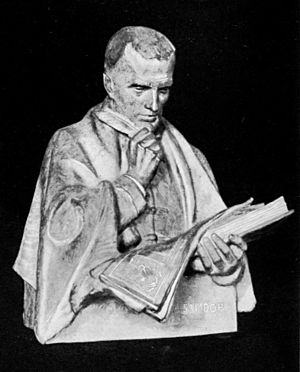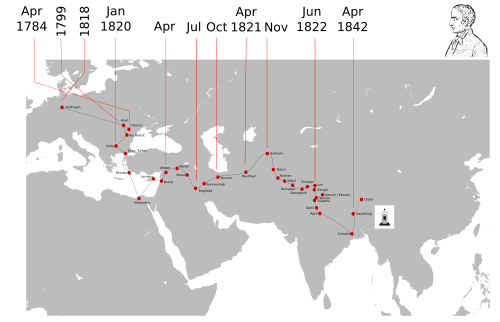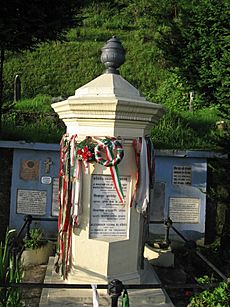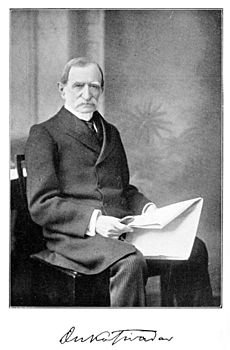Sándor Kőrösi Csoma facts for kids
Quick facts for kids
Alexander Csoma de Kőrös
|
|
|---|---|
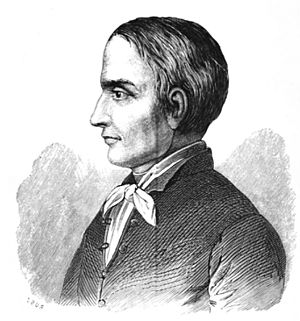 |
|
| Born |
Sándor Csoma
27 March 1784 Kőrös, Grand Principality of Transylvania (today part of Covasna, Romania)
|
| Died | 11 April 1842 (aged 58) |
| Occupation |
|
Sándor Csoma de Kőrös (born Sándor Csoma; 27 March 1784 – 11 April 1842) was a famous Hungarian expert in languages and cultures of the East. He wrote the very first Tibetan–English dictionary and grammar book.
In Tibet, people called him Phyi-glin-gi-grwa-pa, which means "the foreign pupil." In 1933, the Japanese even called him a bosatsu or bodhisattva, a kind of saint. He was born in Kőrös, a place in what is now Romania. Csoma de Kőrös is seen as the person who started the study of Tibet, known as Tibetology. He was said to know how to read in seventeen different languages!
Csoma belonged to the Székelys, a Hungarian group who believed they came from Attila's Huns. He wanted to find out if this was true by studying languages. In 1820, he began a long journey to Asia to find the original home of the Székelys and Hungarians. He spent his life studying the Tibetan language and Buddhist ideas. He died in Darjeeling in 1842 while trying to reach Lhasa.
Contents
Discover the Life of Sándor Csoma de Kőrös
Early Life and Education in Transylvania
Sándor Csoma de Kőrös grew up in a poor Székely family. He was the sixth child of András Csoma and Krisztina Getse. His name in English would be Alexander Csoma of Koros. His father was a soldier in the Székely Border Guards.
Sándor went to a local village school first. In 1799, he joined the Bethlen Kollégium, a boarding school in Nagyenyed (now Aiud). He got free education there by doing manual labor. A professor named Samuel Hegedüs greatly influenced him.
After leaving school in 1807, he continued his studies at university. He became very interested in history. In 1815, he finished his studies at Bethlen Kollégium. He then received a scholarship to study at the University of Göttingen in Germany. There, he started learning English and was influenced by Professor Johann Gottfried Eichhorn.
Studying Languages in Göttingen
From 1816 to 1818, Csoma de Kőrös focused on learning languages from the East. At Göttingen, he was known for knowing thirteen languages. These included Latin, Greek, Hebrew, French, German, and Romanian, besides his native Hungarian. Later, in Calcutta, he also learned Bengali, Marathi, and Sanskrit.
He returned to Transylvania in 1818. In February 1819, Csoma told his old professor, Hegedűs, that he planned to learn Slavonic in Croatia. He walked to Agram and stayed there for a few months. He received some money from Michael de Kenderessy to help him on his journey.
Csoma's Journey Eastward
Csoma's amazing journey after leaving Croatia is known mostly from a letter he wrote. He sent it to a British Captain Kennedy who stopped him, thinking he might be a spy. Csoma did not get an Imperial passport but used a Hungarian one.
He visited Bucharest and then went to Wallachia in late 1819. He tried to go to Constantinople but couldn't find a way. So, on January 1, 1820, he left Bucharest. He crossed the Danube River and reached Sofia, then Plovdiv.
Adventures in the Middle East and Central Asia
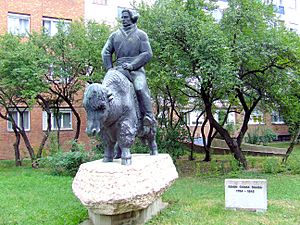
Csoma de Kőrös arrived in Edirne (Adrianopolis). He wanted to go to Constantinople but had to leave because of a plague. He sailed to Alexandria in Egypt, but another plague made him leave quickly. He then took ships to Larnaca in Cyprus, then to Tripoli and Latakia.
From Latakia, he walked to Aleppo in Syria, arriving on April 13. He left in May, joining different groups of travelers and using a raft on a river. He went through Urfa, Mardin, and Mosul, finally reaching Baghdad on July 22. He asked for help from the British resident, Mr. Rich. He received European clothes and money from a Hungarian friend, Mr. Swoboda.
He left Baghdad on September 4, traveling with a caravan through Kermanshah and Hamadan. He reached Tehran on October 14, 1820. He stayed there for about four months with help from Henry Willock. On March 1, 1821, he left Tehran. He changed from European clothes to Persian ones and left notes in Hungarian in case he died.
He reached Meshed on April 18. Because of problems in the area, he couldn't continue until October 20. He arrived in Bukhara on November 18. He planned to stay for the winter but left after five days, fearing the Russian army. He joined a caravan that went through Balk, Kulm, and Bamian. He finally reached Kabul on January 6, 1822.
He left Kabul on January 19 and headed towards Peshawar. On January 26, he met two French officers, Messrs. Allard and Ventura. They traveled together to Lahore. He reached Lahore on March 11 and left on the 23rd. He passed through Amritsar and Jammu to reach Kashmir on April 17.
On May 9, he left Kashmir and reached Leh on June 9. He found the route to Yarkand too dangerous. On his way back to Kashmir, on July 16, 1822, he met William Moorcroft, a famous English explorer. Csoma decided to stay with Moorcroft and went back to Leh with him. There, Moorcroft introduced Csoma to George Trebeck. Moorcroft also lent Csoma a book called Alphabetum Tibetanum. Csoma helped Moorcroft by translating a Russian letter into Latin.
Before Moorcroft left Leh, Csoma asked to stay with Trebeck. He then went with Trebeck back to Srinagar on November 26. He stayed there for over five months. During this time, he became very interested in the Tibetan language. He discussed with Moorcroft his desire to study the books found in local monasteries.
Studying in Ladakh
Moorcroft wrote letters to help Csoma get support from the chief officer at Leh and a Lama in Zanskar. Csoma left Kashmir on May 2, 1823, and reached Leh on June 1. From there, he traveled to Yangla on June 9. He stayed in Zanskar from June 20, 1823, to October 22, 1824.
In Zanskar, he studied with a Lama. As winter approached, he decided to move to Kullu. He reached Subathu on November 26. There, Captain Kennedy stopped him, thinking he was a spy. However, a letter from Moorcroft explained who Csoma was. It took until May for the government in Calcutta to clear him of any suspicion.
On June 6, 1825, he left Subathu and returned to Zanskar. He came back to Subathu on January 17, 1827. He was a bit sad because his Lama teacher couldn't give him enough time. Captain Kennedy wrote that Csoma wanted to talk about Tibetan literature. He also noted that Csoma didn't need money and lived a very quiet life.
During his time in Zanskar (he was the first European to visit the valley), he spent sixteen months studying the Tibetan language. He also learned about Indo-Tibetan Buddhism from a local lama, Sangs-rgyas-phun-tshogs. He was one of the first Europeans to truly learn Tibetan. He read two huge collections of Buddhist writings: the Kangyur (100 volumes) and the bsTan-'gyur (224 volumes). These books contained translations of Buddhist texts from India.
From May 1827 to October 1830, he lived in Kanum in Upper Bashahr. There, he studied the Tibetan manuscripts he had collected in Ladakh. The British government gave him a monthly payment of 50 rupees. Once his dictionary and grammar were finished, Csoma went to Calcutta to get them published.
During his travels, Csoma used different names to fit in. These included Sikander (from Alexander) with titles like Beg or Mulla. He was also called Rumi or Roome, which became Rumpa in Tibetan, meaning he was from Rome. Sometimes he signed his name as Secunder Roome.
Life in Calcutta and Darjeeling
In 1831, Csoma joined the Royal Asiatic Society of Bengal in Calcutta. In 1833, he was made an honorary member of the Asiatic Society. In 1834, he became an honorary member of the Royal Asiatic Society as well. From 1837 to 1841, he worked as the Librarian for the Asiatic Society.
In 1842, he planned to travel to Lhasa, the capital of Tibet. But while traveling, he got malaria and sadly died in Darjeeling.
Csoma's Simple Lifestyle
Csoma lived a very simple life, like an ascetic. He often slept on the bare ground. He ate mostly bread, cheese, fruit, salad, or boiled rice and tea. He rarely ate meat and never drank alcohol. People said he could go for days without drinking water. He was able to "live in the most challenging situations in the most difficult climates and places." He never asked for money for his important work.
Honoring Sándor Csoma de Kőrös
The Asiatic Society of Bengal placed a memorial at Csoma's grave in Darjeeling. It is now a historical monument. The Hungarian government also placed a tablet there. It has words from Count Istvan Szechenyi: "A poor lonely Hungarian, without applause or money but inspired with enthusiasm sought the Hungarian native country but in the end broke down under the burden."
There's a project to fix up the old royal palace (Kharkongma) in Zangla. This is where Csoma de Kőrös lived and worked on his Tibetan–English dictionary.
On February 22, 1933, he was declared a Bodhisattva (a Buddhist saint) in Japan. A statue of him sitting in a lotus position was placed at the shrine in Tokyo Buddhist University. In 1984, for his 200th birthday, the Hungarian government released a postage stamp showing him and his travels. In 1992, a park in his memory was opened in Tar, and the Dalai Lama himself opened it.
- Hungary honored Csoma with a postage stamp on July 1, 1932.
- On March 30, 1984, another Hungarian stamp showed Csoma, the expert in Tibetan language. A map of Tibet was in the background.
Books by Csoma de Kőrös
- Essay towards a Dictionary, Tibetan and English, published in Calcutta, 1834.
- Analysis of the Dulva, a part of the Kangyur, published in Calcutta, 1836.
- Essay towards a Dictionary, Tibetan and English, reprinted in Budapest, 1984.
- A Grammar of the Tibetan Language in English, published in Calcutta, 1834.
- Grammar of the Tibetan Language, reprinted in Budapest, 1984.
- Sanskrit-Tibetan-English Vocabulary: being an edition and translation of the Mahāvyutpatti, published in Budapest, 1984.
- Collected works of Alexander Csoma de Körös, published in Budapest, 1984.
Books and Films About Csoma de Kőrös
- Books
- Duka, Theodore Life and works of Alexander Csoma de Kőrös. London: Trübner, 1885.
- Mukerjee, Hirendra Nath Hermit-hero from Hungary, Alexander Csoma de Koros, the great Tibetologist. New Delhi: Light & Life Publishers, 1981.
- Le Calloch, Bernard Alexandre Csoma de Kőrös. Paris: La nouvelle revue tibétaine, 1985.
- Fox, Edward The Hungarian Who Walked to Heaven (Alexander Csoma de Koros 1784-1842). Short Books, 2001.
- Films
- A Guest of Life, a film by Tibor Szemző, 2006.
- Zangla - Path of Csoma, a film by Zoltán Bonta, 2008.
- Scholarly Articles
- "New Discoveries about Alexander Csoma de Kőrös and the Buddhist Monasteries of Northern India" by Judith Galántha Herman.
- "Alexander Csoma de Kőrös the Hungarian Bodhisattva" by Dr. Ernest Hetenyi.
Where to Find Csoma's Works
- You can find original copies of his Tibetan and English Dictionary and Grammar of the Tibetan Language in English at the British Library.
See also
 In Spanish: Sándor Kőrösi Csoma para niños
In Spanish: Sándor Kőrösi Csoma para niños


